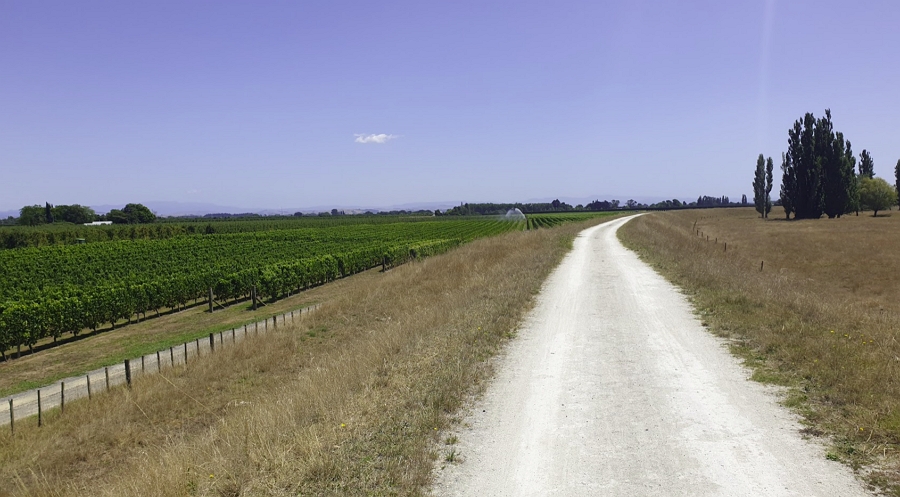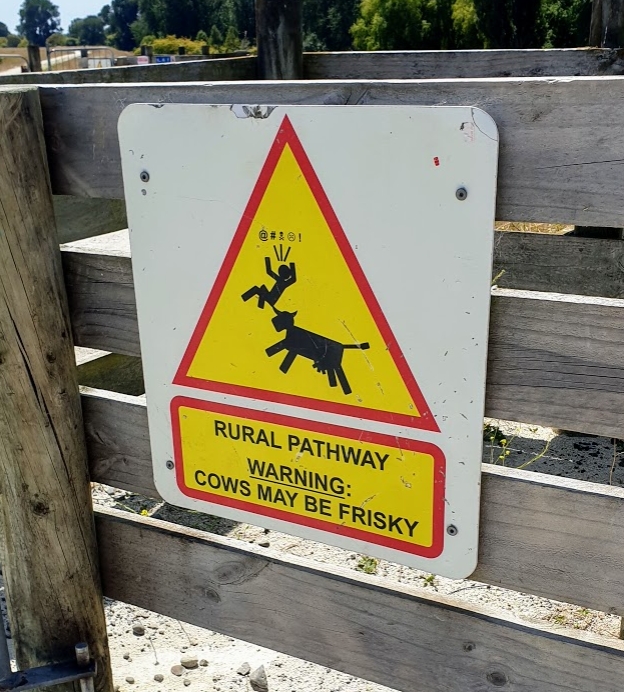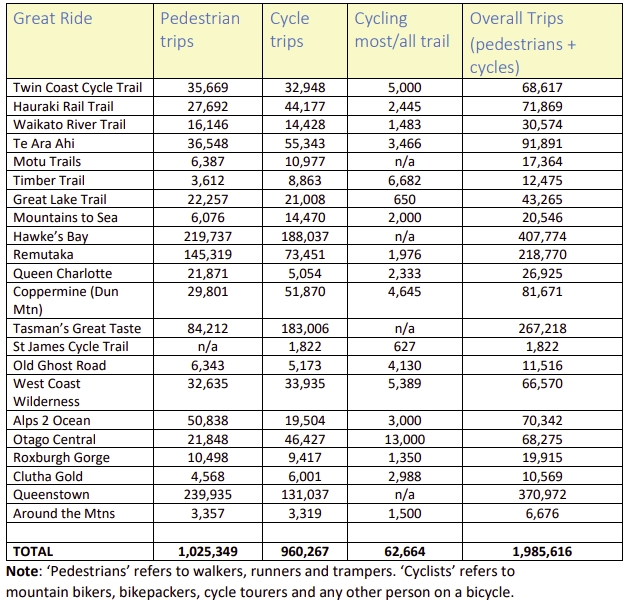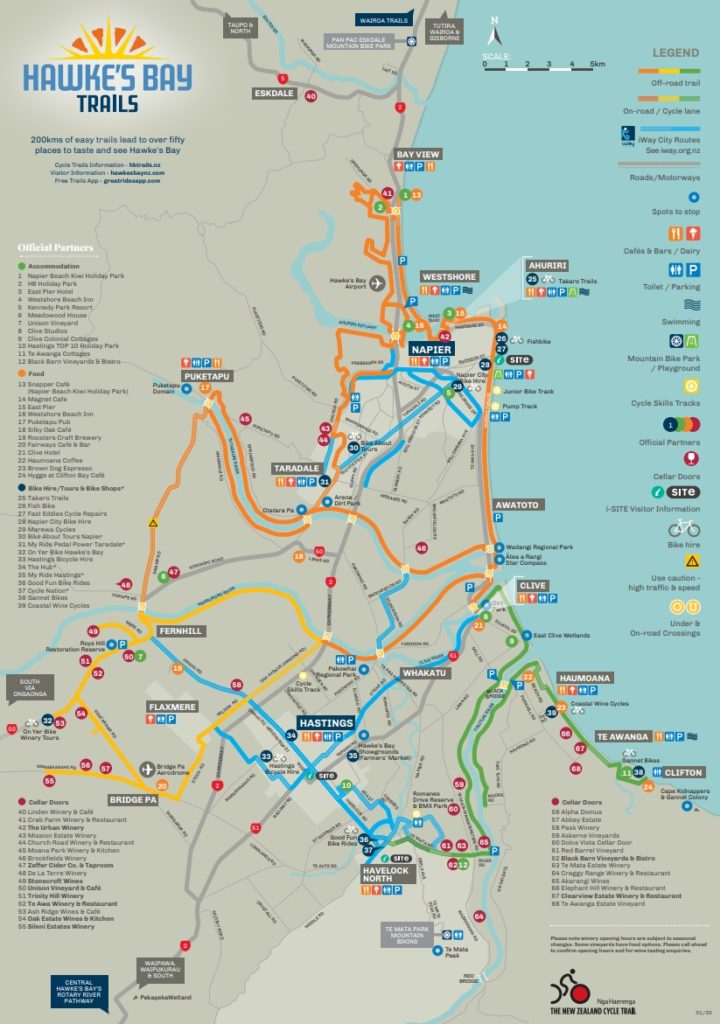There were a couple of bits of cycling news yesterday.
The government were yesterday celebrating the success of walking and cycling tourism.
Cycle trails and cycle and walking tourism are more popular than ever, with nearly two million trips on the country’s Great Rides in one year, says Tourism Minister Stuart Nash.
“New analysis of data from the 22 trails which form the Great Rides shows an increase of nearly 700,000 trips in the year to February, compared to 2015,” said Mr Nash.
“The Great Rides offer intrepid travellers a low-cost and accessible way to see the best parts of the country by going off-road. The rides are graded from easy to expert, and offer something for riders and walkers of all abilities.
“Cycling and walking these trails is a great way to explore unique scenery and enjoy the best of local culture, architecture, food and wine. Cycle trails are growing in popularity with travellers who want to combine health and fitness activities with leisure and holidays.
“Cycleways and walkways are increasingly helping small regional communities to diversify their local economy. They support more tourism, accommodation and hospitality jobs. I encourage travellers to explore one this summer and support local businesses.
“Of all the Great Rides, the Hawke’s Bay Cycle Trail came out on top with 188,000 cycle trips and 220,000 pedestrian trips.
…..
“Research shows that pre-COVID, more domestic visitors to Hawke’s Bay used the region’s cycle trails than international tourists, contributing an estimated $10 million-plus to the local economy. That’s an important advantage for Hawke’s Bay as border restrictions to keep us safe from the pandemic have seriously impacted visitor numbers.
“The report analyses data from automated counters on the 22 Great Rides between 1 March 2019 and 28 February 2020. There are between one and 14 counters per Great Ride. The majority of counters or sensors can distinguish between cyclists and pedestrians, and also can determine the direction of travel.
“The highest users of the trails were pedestrians including walkers, runners and trampers, clocking up just over 1 million trips, followed by cyclists with 960,200 trips.
There are a few things that stand out from this for me.
- Once again this shows that people respond to what we build and if we provide good infrastructure and experiences that people will use it. This is something worth remembering when it comes to our urban areas too.
- The comments on the research in Hawkes Bay are fascinating and also helps to highlight that New Zealanders are keen to have more options to ride a bike. It’s something that is also noticeable at this time of year at many of the popular beach towns around the country where people cruising on a bike is much more common sight.
- We sometimes see some odd arguments in the transport sphere from walkers towards cyclists. This shows how important it is that we don’t have pedestrian vs cyclist debates but advocating for improvements for pedestrians and cyclists
Here are the numbers for each of the great rides with the top three being the Hawkes Bay, Queenstown and Tasman’s Great Taste
The Hawkes Bay coming out as the busiest was not too much of a surprise as it’s not a single route but a whole network of them linking to a variety of places – highlighting that it’s a complete network that’s a key factor. Many parts of the network are also useful for local trips. Notably, Queenstown and Tasman are some of the other more developed networks as opposed to being just one or two routes.

Imagine if we built some complete networks in our main urban areas? Though perhaps without sharing the path with cows.

At the other end of the spectrum, we’ve got this article yesterday on the Te Whau pathway where a few residents are trying to stop the project with most of the arguments seemingly about not wanting the pathway near their backyards.
Residents have vowed to keep battling a $69 million shared path in Auckland intended to connect the community with nature.
The New Lynn-based Upper Te Whau Concern Group says it will appeal resource consent granted this month for 10.4 kilometres of the Te Whau Pathway, a 15-kilometre causeway for pedestrians and cyclists.
The group of Koromiko St residents earlier made submissions against the walkway which they feared would be intrusive.
They were worried about security and privacy and were also concerned the path would damage the “ecologically sensitive” area with mangroves and at-risk birdlife.
Thankfully the council don’t seem to be backing down to them.
Rod Sheridan, Auckland Council’s general manager of community facilities, said 368 submissions were received – with 306 supporting the resource consent application, 57 opposing it and four neutral.
The concerns of all submitters were addressed through an independent application process, he said.
“After reviewing the application, independent commissioners have agreed that Auckland Council has either addressed the adverse effects or will do so through the 168 conditions that will guide how works can be undertaken.”
Sheridan said the government funding supports educating people on water quality, caring for rivers and the environment, the ecological corridor, the integrated environmental restoration plan and native plant nurseries.
Te Whau Pathway will be a fantastic addition to the city once it is completed.




 Processing...
Processing...
It will be great if eventually we can get to many of New Zealand’s cycle trails by train or bus. It seems from our local Kapiti trails the preferred – and perhaps only – way of getting to many of them is using large SUVs carrying bikes. In Europe long distance buses carry bikes as do their trains. On the Kapiti line in the weekends the small trains can only carry 3 bikes per trip.
Do the figures also show the weekday use: indicating how many people commute by bike in say Napier, Hastings or Nelson/Richmond? And Palmerston North which is already a significant commuter cycling city_ because of the students- has the makings of a tourism cycle network with its relatively new ped/cycling bridge over the Manawatu.
Cool, I’m keen on trying some of these areas out. But is this really for the year to February so for 2019? What will it be like for 2020? And did it really take 10 months to be released – isn’t that a bit kinda slow?
It’s a research paper rather than an annual data release.
In my line of work I’ve had to do quite a bit of analysis where the cut off is Feb 2020 recently as the data after this doesn’t really tell a useful story, unless of course the purpose is to examine the impact of Covid.
https://at.govt.nz/projects-roadworks/henderson-cycle-network/ Not the greatest time for a consultation but hope many of you can comment on this one. Would be great if this network was built with interconnected slow street network to give access to all ages and abilities.
The cycle trail network in Melbourne is fantastic, It reaches all over the city. Something to aspire too. Doesn’t get nearly as many commuters as I expected it would however.
Wow how can you oppose a bike way on environmental grounds. The same people whose cars have likely been polluting the environment for decades.. Imagine if $500 million (instead of on Mill road) was put into developing these pathways all over Auckland linking up various existing routes.
As expected, all boomers in the article – “devastated” about a path going in. Get a grip and some perspective on life. You could be devastated about a global pandemic killing thousands, but a beautiful shared path to hopefully reduce our emissions, improve people’s health and wellbeing.
They’re not crossing their arms properly, so the path will be built anyway.
Yeah, gotta get that proper arms crossed look.
The “Upper Te Whau Concern Group” doesn’t actually seem to exist except for the Stuff article. Not even on Scoop or Facebook. So I hope their membership of few can be appeased and will love the path when it eventually is built.
Should be fantastic to have use of the Te Whau pathway if it ever gets completed. Just wondering will this pathway ever be seen as a tourist attraction like the others mentioned in the post? Are there enough points of interest to claim it is a tourist attraction or will it be more of a commuter pathway?
Te Whau will form a loop that takes in NW causeway, Waterview Path and Avondale to New Lynn. The aim to create access to Te Whau, link the two harbours and incorporate local art, heritage and culture should make it of interest to many visitors. Bike Te Atatu recently ran a bird spotting ride with a council expert that went down very well. Te Whau will showcase the natural environment that has been so often overlooked in this part of the city.
Sounds great. I’m sure businesses may even pop up along the route to add more points of interest.
Perhaps different purposes at different times of the day. The environment it goes through will become a tourist attraction in its own right.
Yes you’re right. The river has a long history and the environment has its own story to teach us.
The opponents of the Te Whau cycle- and walkway are just engaging in typical NIMBY behaviour. As I’ve grown older I’ve become shocked at how oppositional my Boomer friends have become to ANY new innovation. People who were liberal and progressive earlier in life; it seems that this may be a natural response to ageing. Let’s hope their descendants give them a stern lecture about the folly of spending their hard-earned retirement savings on court costs – because these will be massive if they go for an appeal.
They’re particularly upset that they’ll have people walking and cycling close to their houses. Guess what – so do I. That’s because I live in a street. If you don’t want to see people, go and live in a rural area!
As usual most of the objections are far fetched and not really plausible. People make these objections up as the real reason is that they just don’t want it there. It is the same with on road cycle lanes but the real reason in these cases is parking.
The cycle lanes and new bustops are almost complete on Lambie drive. In my opinion they look quite good. I will look forward to see what they do on Puhinui Road especially the section from Lambie drive to Puhinui Station.
They are on my way to work. Surprised it even got built tbh. One of many scary falls in my route. Can contemplate biking soon.
The Cycle Tourism aimed at novice gravel road tourers is brilliant, I’m sure it has inspired many people to get out more on bikes. I know a few “boomer” types who haven’t ridden bikes for decades, but now do Rail Trail holidays.
This report doesn’t look at mountain biking, which I am a big fan of. NZ has some of the best MTB riding around and is big tourist attraction. We have many MTB parks. But MTB itself seems to mostly fossil fueled.
The Woodhill carpark was recently expanded, and is full most summer weekends. I drive there from Auckland, its about 40 kms on SH16, a road which only the hardcore roadies are keen to ride. I’ll happily ride to Westgate and then to the Shore via shared paths – how about a path all the way out past Kumeu?
An MTB group I am involved with did trial a bookable bus and trailer combo for shuttling people to Woodhill but the response was dire. No normal buses in Auckland take bikes. The railway runs right past Woodhill forest, imagine if the train stopped nearby!
Totara Park in Manukau is only 3 kms from Manukau station but you would need to ride up Redoubt Road with a death-wish to get there.
Work is in progress just south of the Meadow Bank railway station. I assume this is a cycleway walkway to link through to the already completed section at Glen Innes.
Yes, it’s phase three of the shared path that will eventually connect with the CBD.
As an occasional reader, and even less occasional commentator, to GA, I should not be surprised to see no acknowledgement of John Key as PM and Minister of Tourism that pretty much got the New Zealand Cycle Trail and Great Rides underway in 2009.
In the absence of anyone else I tilt my hat to Key for getting this program beyond talk fests and actually underway.
The article was a critique of progress on urban cycling amenities, using not only the national cycle trail but also Hawkes Bay of examples of “build it and they will come”. I dont think JK had a anything to do with the latter.
Still, if you must be needlessly offended by your perceived political bias of the blog, so be it. I believe you call the lefties “snowflakes” in similar circumstances?
I have used the trails in Hawke’s Bay extensively and they are well maintained. The weekend use makes them very busy with whole families out for a ride or walk. The network continues to grow and the planners have finally understood that it is not just people on off-road type bikes that use the facilities. Plenty of commuters between Napier-Hastings each day on road bikes and there is a lot of work to provide safer on-road cycle lanes. The recent work between Clive and the bridge over the Tutaekuri River is testament to that. There is also a new on-road bike lane on both sides of Napier Road that will link Havelock North to the roundabout on SH2. This will then leave just a short segment left to Clive to complete the ‘commuter’ network between Napier and Havelock North. The route from Hastings to Clive is also in development.